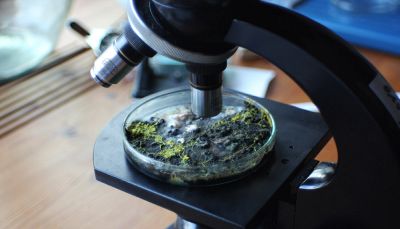Lecturer: Julian Chollet
Credits: 6 ECTS, 4 SWS
Date: Monday (15:15 – 16:45) + individual trainings
Venue: Monday-meeting online / trainings in Marienstraße 7b, DIY BioLab (Room 202)
Syllabus
Our air, soil and water as well as all plants and animals contain complex ecosystems that are colonized by various creatures - most of which we can only see and interact with by virtue of microscopy or cultivation techniques.
This course aims to introduce you to the methodologies, project planning and experimental strategies in the natural sciences – mainly through the use of microscopy techniques. In line with the concept of a hybrid semester, the theoretical input will be communicated through online lectures while the practical skills will be acquired in individualized block-modules. While working in the DIY BioLab (Chair of Media Environments) you will learn how to use different kinds of microscopes and start your own little research project. Beyond the microscopy itself, educational objectives include literature research, experiment design, result documentation and scientific writing.
The course will be structured in a flexible way, tailored to the needs of the participants. Attendance during the online-seminars and hands-on module, as well as the delivery of detailed project documentation (paper, artwork, etc.) until the end of the semester is required. The course can be combined with the module “Flagelates, Nematodes, and I” by Mindaugas Gapševičius.
Please write a motivational letter to julian@mikrobiomik.org until 27.10.20 – if you already worked with biology before, please include a short description of the project and your level of experience.
Students
Basic concepts
Life
"There are over a 100 definitions for 'life' and all are wrong"
http://www.bbc.com/earth/story/20170101-there-are-over-100-definitions-for-life-and-all-are-wrong
https://en.wikipedia.org/wiki/Life#Definitions
Since there is no unequivocal definition of life, most current definitions in biology are descriptive. Life is considered a characteristic of something that preserves, furthers or reinforces its existence in the given environment. This characteristic exhibits all or most of the following traits:
Homeostasis Organization Metabolism Growth Adaptation Response to stimuli Reproduction
Organism
https://en.wikipedia.org/wiki/Organism
In biology, an organism (from Greek: ὀργανισμός, organismos) is any individual entity that exhibits the properties of life. It is a synonym for "life form".
Organisms are classified by taxonomy into specified groups such as the multicellular animals, plants, and fungi; or unicellular microorganisms such as a protists, bacteria, and archaea. All types of organisms are capable of reproduction, growth and development, maintenance, and some degree of response to stimuli.
Prokaryote
Prokaryotes are represented by two separate domains—bacteria and archaea. A unicellular organism that lacks a membrane-bound nucleus, mitochondria, or any other membrane-bound organelle.
Eukaryote
Eukaryotic organisms are characterized by the presence of a membrane-bound cell nucleus and contain additional membrane-bound compartments called organelles (such as mitochondria in animals and plants and plastids in plants and algae, all generally considered to be derived from endosymbiotic bacteria). Fungi, animals and plants are examples of kingdoms of organisms within the eukaryotes.
Microorganism
Living beings that are too small to be seen with the (human) eye.
https://en.wikipedia.org/wiki/Microorganism
https://en.wikipedia.org/wiki/Human_interactions_with_microbes
They live in almost every habitat from the poles to the equator, deserts, geysers, rocks and the deep sea. Some are adapted to extremes such as very hot or very cold conditions, others to high pressure or [...] high radiation environments. Microorganisms also make up the microbiota found in and on all multicellular organisms.
Microbes are important in human culture and health in many ways, serving to ferment foods, treat sewage, produce fuel, enzymes and other bioactive compounds. They are essential tools in biology as model organisms and have been put to use in biological warfare and bioterrorism. They are a vital component of fertile soils. In the human body microorganisms make up the human microbiota including the essential gut flora. They are the pathogens responsible for many infectious diseases and as such are the target of hygiene measures.
The possible existence of unseen microbial life was suspected from ancient times, such as in Jain scriptures from 6th century BC India and the 1st century BC book On Agriculture by Marcus Terentius Varro. Microbiology, the scientific study of microorganisms, began with their observation under the microscope in the 1670s by Antonie van Leeuwenhoek.
Suggested resources regarding the proposed projects/topics
Cytoplasmic streaming
PDFs
File:Guide_to_scientific_writing.pdf
